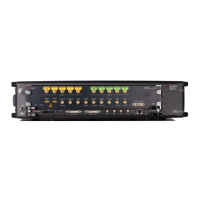Config (Configuation): A configuration entry is like normal data entry
connected to sample data from the waveform memory but no segment
loop count is available. Each configuration entry has a link to an entry of
the Action Table and can initiate the execution of the corresponding
action while playing the associated sample data. Config entry is allowed
only in interpolated mode.
Idle: Idle entry allows setting a pause between segments in a granularity
that is smaller than the sync clock granularity. You can specify the sample
to be played during the pause. A minimum length of this pause is
required. The idle command segment is treated as a segment within
sequences or scenarios. There is no segment loop count but a sequence
loop counter value is required for cases where the idle command segment
is the first segment of a sequence.
Empty: Select this option to create an empty segment entry. An entry
after the empty segment is automatically marked as a new sequence.
Segm.# (Segment Number)
Allows to enter the segment number.
Segm. Loop (Segment Loop)
Specifies the segment loop count (number of times the selected sequence entry is
repeated).
Segm Start Off. (Segment Start Offset)
Allows specifying a segment start address in samples, if only part of a segment
loaded into waveform data memory is to be used. The value must obey the
granularity of the selected waveform output mode. .
Segm End Off. (Segment End Offset)
Allows specifying a segment end address in samples if only part of a segment
loaded into waveform data memory is to be used. The value must obey the
granularity of the selected waveform output mode.
Segm.Adv. (Segment Advance)
Allows the user to set the segment advancement mode.
Any of the following segment advancement modes can be selected:
Auto (Automatic): After having executed all loops, the sequencer
advances to the next element automatically. No external interaction is
required for advancement.
Cond (Conditional): The sequencer repeats the current element until it
receives the correct advancement event. After having received the
advancement event, the current element is played to the end before
switching to the next one.
Repeat: After having executed all loops the sequencer stops and plays the
last value of the current element. After having received the advancement
event, the sequencer starts playing the next element. When receiving the
advancement event before having played all repetitions, all repetitions will
be played before moving to the next element.
Single: After having executed an element once, the sequencer stops and
plays the last value of the element. After having received the next
advancement event, the process is repeated until having executed all
loops of the current element. Then the execution advances to the next
element.
Marker
This option allows to enable or disable the marker.

